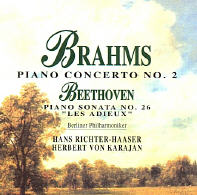
Opening with a horn theme, the spacious first movement quickly introduces the piano in an exploratory way which soon crystalises into piano flourishes and a grand orchestral statement built on the horn melody. Although passionate at times, the movement is congenial, in contrast to the massive Scherzo that follows.
In the Andante Brahms introduces a solo cello alongside the piano to make a tender love duct. Now comes some of that rare Brahmsian musical humour: a playful finale teeming with subtle touches and with a quiet smile at every turn.
Beethoven was not the man to bow down before nobility but in the Piano Sonata in E flat he makes an exception. His patron, Archduke Rudolph, left Vienna in May 1809 to escape Napoleon's army. In the first movement of his Sonata Beethoven clearly says 'Lebewohl' ('Farewell') in the opening phrase, and goes into an Allegro in which disquiet implies regret at the loss of valued friend. Continued absence is poignantly conveyed in the middle movement, but in the finale there is an explosion of joy when, after seven months, the Archduke and Beethoven were reunited in Vienna.
Robert Dearling.
Discontinued
Piano Concerto No.2
